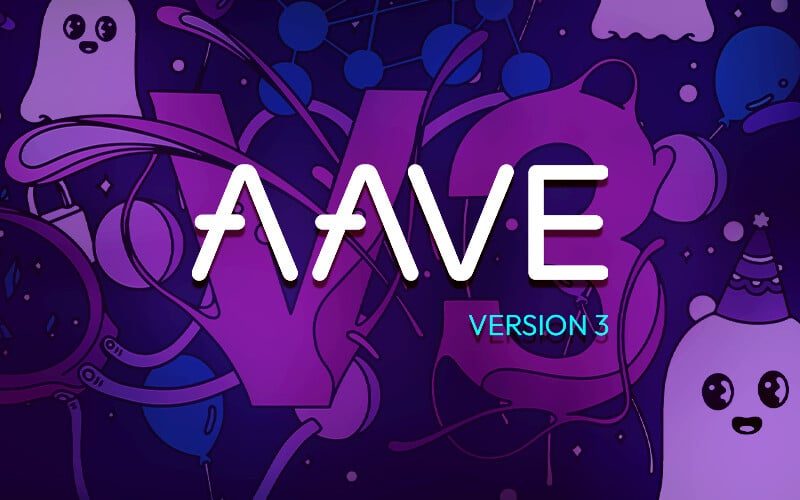This article introduces the AAVE liquidity protocol and the associated AAVE token. AAVE is one of the leaders of decentralized finance (defi) and continues to thrive during this downward market.
AAVE: A Decentralized Bank
AAVE was originally built on Ethereum which is the starting place for many popular decentralized applications. Ethereum, being the leader of the space for smart contract platforms, draws the largest amount of capital considering its history of security and reliability. Ethereum although slow and expensive, is immensely secure and decentralized, two attractive qualities for any main blockchain network. AAVE allows holders of various crypto assets to lend on an open market in return for a yield in the same asset.
AAVE functions similarly to a bank in that it holds funds in a secure manner for its customers. AAVE will take these assets and allow other users to borrow, which creates debt for an interest rate. AAVE pays the lender back using the interest rate that the borrowers accrue over time.
Furthermore, AAVE requires collateral with crypto assets for borrowing. This allows for risk mitigation incase the borrower defaults, the crypto collateral will be taken in exchange. Since AAVE is decentralized, the middleman(bank) is removed from the equation, lenders and borrowers interact directly.
Users interacting with AAVE only need to pay the fees associated with the blockchain they are using. AAVE has also integrated Polygon, Avalanche, Harmony, Arbitrum, Fantom, and a few other blockchains for its liquidity protocol. AAVE has been audited several times and uses the built-in security for each blockchain it interacts with. AAVE also has a token which functions primarily for voting purposes on chain and staking for rewards including protocol fees [1].
Importance of Defi

Imagine a neighborhood with no bank, instead the community lends and borrows freely with a system of rules. Neighbor A wants to borrow 10,000$ in USDC to withdraw as cash to a checking account for a new car. This neighbor has 15,000$ of a crypto asset as collateral to deposit. Neighbor B is willing to lend the funds, assuming that the borrower will pay a flat 3% interest rate yearly.
This transaction is peer to peer, neither neighbor is aware of the identity of the other, but using smart contracts they are able to interact with this set of predetermined rules. If neighbor B is unable to pay said interest rate for x amount of time, the collateral deposited is taken and given to the protocol to cover the borrow, the lender is then repaid. Since the smart contract determines the rulesets ahead of time, both parties were aware of the rules of the game to transact with each other.
Defi is important because this process takes away the greedy third party that typically takes users’ funds and makes a massive profit on them. Banks achieve massive wealth by using the neighborhood’s money and investing it. Banks also make money passing out debt with an interest rate through mortgages, credit cards, and other loans. Many bank users are not aware, but they use collateral and credit all the time without users noticing.
Any loan that is taken out, if not paid on time every month can result in a lower of credit score, and seizure of assets including property, and other valuable items. The smart contract protects both peers with an immutable, and mathematical system that has no biases or human error.

Some AAVE Metrics
Today, AAVE has 9.2 billion dollars locked into the protocol through the various chains. Users who decide to stake AAVE for a yield, receive rewards in more AAVE tokens. Currently 15% of the AAVE token supply is staked, keeping that token supply from the open market for trade [2]. AAVE holders have the added benefit of rights to vote for changes to the protocol based on percentage ownership.
During upward markets, lending protocols are tremendously important as they stimulate the explosive growth in volume and trading. The opposite is true during downward markets like we are seeing today. Less credit in the market usually equates to lower asset prices, this is playing out in the assets markets in 2022 because credit is reducing. AAVE presents a potential long-term opportunity as it will likely thrive during the next upward market, and downward markets are the best time to buy for the long term.
AAVE token has almost 90% of its total token supply released which should reduce sell-pressure over time. AAVE as an asset finds itself 87% from the all-time-high. The token is readily available on most major exchanges, and decentralized token swapping applications(Uniswap etc). AAVE also takes a top spot in many crypto VC firm/institutional asset holdings. Stay tuned for our review of the AAVE token coming in the next few weeks. We will review the token economics and ecosystem to evaluate the future potential value of AAVE. Please remember none of this is financial advice, stay safe out there!
[2] https://www.stakingrewards.com/earn/aave/
















